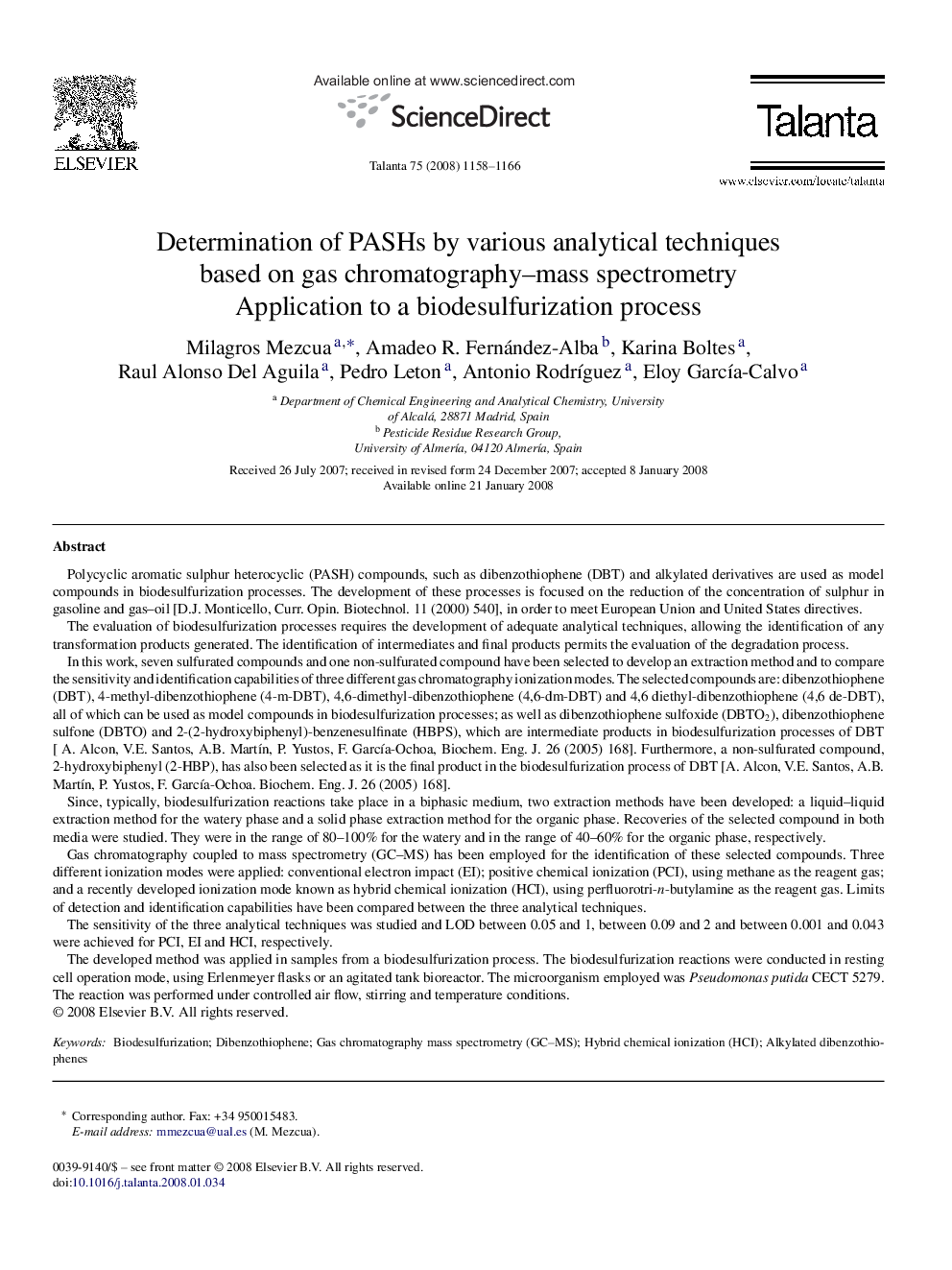| کد مقاله | کد نشریه | سال انتشار | مقاله انگلیسی | نسخه تمام متن |
|---|---|---|---|---|
| 1244286 | 969684 | 2008 | 9 صفحه PDF | دانلود رایگان |

Polycyclic aromatic sulphur heterocyclic (PASH) compounds, such as dibenzothiophene (DBT) and alkylated derivatives are used as model compounds in biodesulfurization processes. The development of these processes is focused on the reduction of the concentration of sulphur in gasoline and gas–oil [D.J. Monticello, Curr. Opin. Biotechnol. 11 (2000) 540], in order to meet European Union and United States directives.The evaluation of biodesulfurization processes requires the development of adequate analytical techniques, allowing the identification of any transformation products generated. The identification of intermediates and final products permits the evaluation of the degradation process.In this work, seven sulfurated compounds and one non-sulfurated compound have been selected to develop an extraction method and to compare the sensitivity and identification capabilities of three different gas chromatography ionization modes. The selected compounds are: dibenzothiophene (DBT), 4-methyl-dibenzothiophene (4-m-DBT), 4,6-dimethyl-dibenzothiophene (4,6-dm-DBT) and 4,6 diethyl-dibenzothiophene (4,6 de-DBT), all of which can be used as model compounds in biodesulfurization processes; as well as dibenzothiophene sulfoxide (DBTO2), dibenzothiophene sulfone (DBTO) and 2-(2-hydroxybiphenyl)-benzenesulfinate (HBPS), which are intermediate products in biodesulfurization processes of DBT [ A. Alcon, V.E. Santos, A.B. Martín, P. Yustos, F. García-Ochoa, Biochem. Eng. J. 26 (2005) 168]. Furthermore, a non-sulfurated compound, 2-hydroxybiphenyl (2-HBP), has also been selected as it is the final product in the biodesulfurization process of DBT [A. Alcon, V.E. Santos, A.B. Martín, P. Yustos, F. García-Ochoa. Biochem. Eng. J. 26 (2005) 168].Since, typically, biodesulfurization reactions take place in a biphasic medium, two extraction methods have been developed: a liquid–liquid extraction method for the watery phase and a solid phase extraction method for the organic phase. Recoveries of the selected compound in both media were studied. They were in the range of 80–100% for the watery and in the range of 40–60% for the organic phase, respectively.Gas chromatography coupled to mass spectrometry (GC–MS) has been employed for the identification of these selected compounds. Three different ionization modes were applied: conventional electron impact (EI); positive chemical ionization (PCI), using methane as the reagent gas; and a recently developed ionization mode known as hybrid chemical ionization (HCI), using perfluorotri-n-butylamine as the reagent gas. Limits of detection and identification capabilities have been compared between the three analytical techniques.The sensitivity of the three analytical techniques was studied and LOD between 0.05 and 1, between 0.09 and 2 and between 0.001 and 0.043 were achieved for PCI, EI and HCI, respectively.The developed method was applied in samples from a biodesulfurization process. The biodesulfurization reactions were conducted in resting cell operation mode, using Erlenmeyer flasks or an agitated tank bioreactor. The microorganism employed was Pseudomonas putida CECT 5279. The reaction was performed under controlled air flow, stirring and temperature conditions.
Journal: Talanta - Volume 75, Issue 5, 15 June 2008, Pages 1158–1166